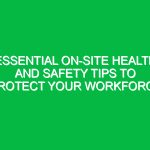Introduction
In today’s increasingly complex business environment, the concept of management risks has become a focal point for organizations, particularly within the Health, Safety, and Environment (HSE) domain. Management risks refer to uncertainties that can impact an organization’s ability to achieve its objectives, particularly in maintaining the health and safety of its employees and minimizing environmental impact. Understanding these risks is crucial for implementing effective strategies that promote a culture of safety and sustainability.
As industries evolve, the landscape of HSE risks becomes increasingly intricate. Companies face challenges such as regulatory compliance, technological changes, and shifting public perceptions. This article delves into the critical management risks associated with HSE, exploring essential strategies for success that organizations can adopt to mitigate these risks effectively.
Understanding Management Risks in HSE
Management risks in the HSE context encompass a broad spectrum of potential hazards that can arise from operational practices, organizational culture, and external factors. These risks can lead to significant consequences not only for the organization but also for employees, communities, and the environment as a whole.
Types of Management Risks in HSE
Understanding the various types of management risks is essential for organizations aiming to navigate the HSE landscape effectively. Here are some of the key types:
- Operational Risks: These are risks arising from day-to-day operations. They can include equipment failures, process inefficiencies, and human errors that could lead to accidents or environmental spills.
- Compliance Risks: Organizations must comply with numerous regulations and standards. Non-compliance can result in legal penalties, fines, and damage to reputation.
- Reputational Risks: An organization’s reputation is paramount. Any incident of negligence or environmental harm can lead to public backlash, damaging trust and customer relationships.
- Financial Risks: Poor management of HSE can lead to significant financial losses through fines, legal fees, and increased insurance premiums.
- Strategic Risks: These risks arise from unforeseen changes in the market, technology, or regulations that can impact the organization’s strategic objectives.
The Importance of Risk Assessment
A comprehensive risk assessment is the cornerstone of effective HSE management. It involves identifying potential hazards, evaluating the risks associated with those hazards, and implementing control measures to mitigate them. Risk assessment serves multiple purposes:
- Identification: It helps in recognizing hazards that could pose risks to health, safety, and environment.
- Evaluation: Organizations can assess the severity and likelihood of risks, which aids in prioritizing risk management efforts.
- Control Measures: The assessment process leads to the development of strategies and controls to mitigate identified risks.
Strategies for Managing HSE Risks
Implementing effective strategies to manage HSE risks is vital for organizational success. Here are several essential strategies that can significantly enhance risk management practices.
1. Foster a Culture of Safety
Creating a culture of safety within the organization is paramount. This involves engaging employees at all levels in discussions about safety practices and encouraging them to take ownership of their roles in maintaining a safe work environment. Regular training sessions, workshops, and safety drills can reinforce this culture.
For instance, a manufacturing company might implement weekly safety meetings where employees can voice concerns and suggest improvements. This participatory approach not only empowers employees but also helps identify potential risks that management may overlook.
2. Implement Robust Training Programs
Training programs are essential for ensuring that employees are aware of the risks they may face and the procedures in place to mitigate them. Effective training should be ongoing and tailored to specific roles and responsibilities. For example, a construction company may require all workers to undergo rigorous safety training that covers equipment operation, emergency response, and hazard recognition.
Moreover, utilizing real-life scenarios during training can enhance understanding. Case studies of past incidents can be used to illustrate the importance of adhering to safety protocols and the potential consequences of negligence.
3. Embrace Technology and Innovation
The integration of technology in HSE management has been transformative. From data analytics to predictive modeling, technology can provide valuable insights into risk trends and help organizations make informed decisions.
For instance, utilizing drones for site inspections can minimize the risk to human life while providing comprehensive data on potential hazards. Additionally, software platforms that track compliance and incident reports can streamline processes and enhance accountability.
4. Regular Auditing and Monitoring
Conducting regular audits and monitoring is crucial for identifying weaknesses in existing HSE practices. Organizations should establish key performance indicators (KPIs) to assess their HSE performance continually. Regular checks can help detect lapses in compliance and provide opportunities for immediate corrective action.
An oil and gas company, for example, might implement a quarterly audit process that reviews safety procedures, equipment maintenance records, and employee training compliance. This proactive approach keeps risks at bay and fosters a culture of continuous improvement.
5. Engage Stakeholders
Engaging stakeholders, including employees, regulatory bodies, and the community, is vital for effective HSE management. Collaboration can lead to better risk identification and management strategies.
For example, a chemical manufacturing plant may hold quarterly forums with local community members to discuss safety measures and environmental impact. This transparency builds trust and allows the organization to address concerns proactively.
Regulations and Standards Governing HSE Management Risks
Compliance with regulations and industry standards is a critical component of managing HSE risks. Various agencies set forth guidelines that organizations must follow to ensure health, safety, and environmental protection.
Key Regulations
Here are some key regulations that govern HSE management:
- Occupational Safety and Health Administration (OSHA): OSHA sets and enforces standards to ensure safe and healthful working conditions for employees in the U.S.
- Environmental Protection Agency (EPA): The EPA regulates hazardous waste management, air quality, and water quality to protect the environment and public health.
- ISO 45001: This international standard provides a framework for organizations to improve employee safety, reduce workplace risks, and create better, safer working conditions.
The Impact of Regulations on Management Risks
Failure to comply with these regulations can result in severe penalties, including fines and legal action. Moreover, non-compliance can lead to reputational damage that affects customer trust and business relationships. Thus, organizations must stay updated on regulatory changes and ensure that their HSE practices align with these requirements.
Real-Life Case Studies
Examining real-life examples of organizations that have successfully navigated management risks in HSE can provide valuable insights.
Case Study 1: BP Deepwater Horizon Incident
The Deepwater Horizon oil spill in 2010 serves as a stark reminder of the consequences of inadequate risk management. BP faced severe regulatory scrutiny, financial losses, and public backlash due to the disaster. The incident highlighted the importance of robust risk assessment and management practices, leading to changes in regulations and industry standards.
In the aftermath, BP implemented stricter safety protocols, invested in technology for real-time monitoring, and increased transparency in communication with stakeholders. This case underscores the critical need for organizations to prioritize HSE management to avoid catastrophic outcomes.
Case Study 2: DuPont’s Commitment to Safety
Conversely, DuPont is an example of a company that has successfully managed HSE risks through a strong safety culture. Their “Safety Differently” approach emphasizes employee participation and accountability. DuPont’s commitment to safety has led to a consistent decline in workplace incidents over the years.
By fostering open communication and encouraging employees to take ownership of safety practices, DuPont has built a resilient organization that prioritizes health, safety, and environmental sustainability.
Conclusion
In conclusion, understanding and managing critical management risks in the HSE domain is essential for organizations striving for success. By fostering a culture of safety, implementing robust training programs, and embracing technology, companies can mitigate risks effectively. Continuous auditing, stakeholder engagement, and adherence to regulations further enhance an organization’s ability to navigate the complexities of HSE management.
As industries continue to evolve, the importance of proactive risk management cannot be overstated. Organizations must remain vigilant and adaptable, ensuring that health, safety, and environmental considerations are at the forefront of their operations. The journey towards effective HSE management is ongoing, but the rewards—improved safety, reduced environmental impact, and enhanced organizational reputation—are well worth the effort.


